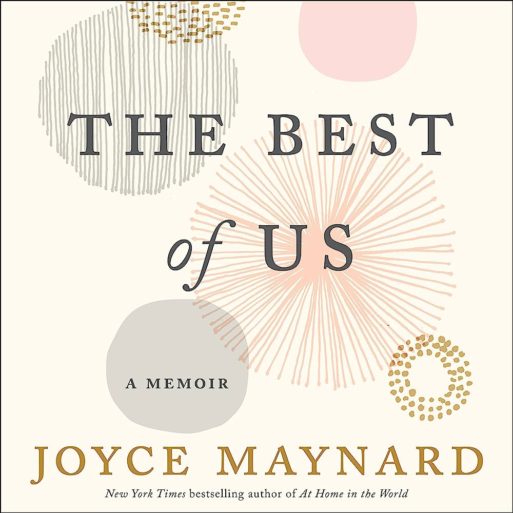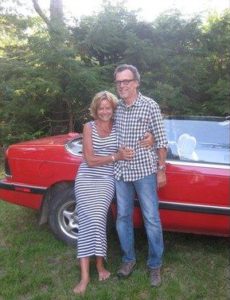 “How do two people get through the day when one of them has a tumor inside his abdomen that may be killing him, and the other is simply consumed with grief?”
“How do two people get through the day when one of them has a tumor inside his abdomen that may be killing him, and the other is simply consumed with grief?”
This is the question that Joyce Maynard asks — and answers — in her 2017 memoir “The Best of Us.”
Powerful. Painful. Brutally honest, Maynard takes us through a journey of love, terminal illness and loss.
“The Best of Us” is a sad story transformed into an inspirational one because of the author’s belief that this tragedy made her and her dying husband better people.
Finding Love at 58
In “The Best of Us,” Joyce Maynard chronicles what it is like to fall in love at the age of 58. She met Jim Barringer, a California attorney, on Match.com. The details of their courtship remind us that you don’t have to be young to feel the overpowering rush of love.
Maynard recounts almost giddily the free-roaming road trips with her newfound love, her feet on the dashboard. She describes the joy of sharing good meals after her quarter-century of being single. She recounts the pleasure derived from a shared enthusiasm for music.
 Joyce remembers the early days of being together, traveling, drinking wine, and falling into bed naked, laughing. “Two people drunk on love.”
Joyce remembers the early days of being together, traveling, drinking wine, and falling into bed naked, laughing. “Two people drunk on love.”
Together, they purchased their beloved, eclectic, isolated house in Hunsaker Canyon, California, and looked forward to spending the rest of their lives together.
But their storybook romance would not have a happily-ever-after ending.
After a little more than a year of marriage, Jim was diagnosed with pancreatic cancer.
“How does a person describe the moment her world ends?” Joyce Maynard wonders when she hears the medical proclamation.
Holding on to Hope
In a desperate attempt to do anything to keep Jim alive, they decide to go for a Whipple procedure, a brutal 14-hour surgery that removed the tumor, but in doing so took a part of Jim’s pancreas, duodenum, gall bladder, and part of his stomach and large intestines. In addition to this surgery, Joyce and Jim search for any conceivable treatment that may change the outcome: They do expensive, $6000 injections, special diets, eating “good dirt” in organic root vegetables, paying for hyperbaric chamber sessions, and undergoing traditional chemotherapy. “Always one more thing that would make the difference.” And because they wanted so much to believe that their story would be different, “against all evidence to the contrary,” Maynard writes, “we held on to hopefulness.”
But no matter how much hope they had, no matter how valiantly they fought, it wasn’t enough. Jim lasted 18 months before he died of pancreatic cancer. They had been married for less than three years.
Reading “The Best of Us” is hard, but it is also compelling.
A Gamut of Emotions
Brutally honest, Joyce Maynard discusses the stages and facets of facing the terminal illness of the man she loves. She describes with concise, searing language the anger, sorrow, inability to think of a future without him, the growing dependence on wine to numb her from reality, the despair of losing a shared life, and the loneliness of watching her husband dying. Maynard lists the gamut of emotions she experiences, from hopefulness to depression and everything in between.
Maynard also discusses the anger she felt when she saw other couples and wondered why they weren’t holding hands. Didn’t they understand how precious their time together was? She even saw other men with big bellies and thought that that man was lucky. After all, “if he got cancer, he could lose fifty pounds and not be in trouble.” Her own husband, Jim, was a lean, slender man and was wasting away to nothing.

Credit: Parade.com
“Remember this moment,” was a repeated phrase. Each time she and Jim did something that she knew they would never do again, she thought to herself, “Remember this moment,” advice that we can all take to heart when in the presence of someone we love.
Why would anyone read a book that is so sad? Because people in similar situations will know that they are not alone. Because illness is a universal experience that will affect all of us or someone we love at some point in our lives. Mostly because there is hope presented in a story where human spirit survives. Maynard manages to keep going on a different path even without her beloved Jim.
Becoming Better People Through Shared Hardship

Credit: Goodreads
The life-and-death struggle they went through made them better people.
. . .the man I lived with now, as diminished as he believed himself to be a scarecrow in a suit with enough room left over inside for another whole person – was a man in possession of more compassion and humility than the one he’d been when times were good. He had become his finest self over the course of his ordeal. Not always, but on my better days, I like to think the same was true of me.”
“It seemed to me, as we approached the moment when everything would be over, finally, that the ordeal of the disease and the treatment — two separate kinds of hell I would wish on no living human — had turned us into two people we might never have become if the disease had spared Jim. Better ones, though only one of us would survive to benefit from this brutal education we’d received.”
Joyce Maynard, American Author
Joyce Maynard is a well-known American novelist, journalist and memoirist, getting her start in the 1970s with an essay published in the New York Times entitled, “An Eighteen-Year-Old Looks Back at Life.” She is known for her affair with the reclusive J.D. Salinger and the memoir she wrote about their relationship, “At Home In the World.” Maynard has published 16 novels and dozens of essays and articles in major news publications.

 “The Best of Us” by Joyce Maynard
“The Best of Us” by Joyce Maynard


 John Mulaney’s “Funeral Planning” on Netflix: No Real Plan
John Mulaney’s “Funeral Planning” on Netflix: No Real Plan

 Composting Bodies Is Now Legal in a Dozen States
Composting Bodies Is Now Legal in a Dozen States














